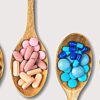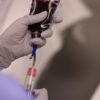Sufferers of celiac disease know all too well the common symptoms of severe nausea, diarrhea, gas, bloating and fatigue that accompany the illness. They also know that adopting — and sticking to — a gluten-free diet will bring long-term relief. But sometimes a gluten-free diet fails to get celiac symptoms under control — known as refractory celiac disease. There is no proven treatment for refractory celiac, but doctors may prescribe drugs off label, such as corticosteroids (prednisone, budesonide) or the immune-suppressing drugs infliximab (Remicade) or azathioprine (Imuran, Azasan), to combat the symptoms. The side effects of both types of drugs are significant.
Corticosteroids work by blocking the effects of a number of chemicals the immune system uses to “kick-start” the process of inflammation. The side effects of prednisone include insomnia, mood changes, increased appetite, slow wound healing, acne and dizziness. Prednisone can also cause nausea, stomach pain and bloating — some of the same symptoms of celiac disease. Budesonide side effects tend to be milder.
Immune-suppressing drugs reduce pain and inflammation, particularly in those with autoimmune diseases. However, the long-term use of infliximab or azathioprine may increase the risk of developing certain types of cancer, including a rare but fast-growing type of lymphoma called hepatosplenic T-cell lymphoma, which can be fatal. The risk is higher in teens and young adults, and in those with existing autoimmune disorders.
Browse This Article
Why Is Gluten a Problem for Celiac Disease?
Celiac disease is a hereditary digestive and autoimmune disorder that affects as many as 3 million people in the US, according to the Celiac Disease Foundation. When celiac sufferers eat gluten (a protein found in wheat, rye and barley), a peptide in gluten called gliadin triggers their body to mounts an immune response that attacks the small intestine.
“In everyone there is a tiny bit of gluten that remains undigested in the body after we consume it — the GI tract can’t process it all,” says Alessio Fasano, MD, chief of the division of pediatric gastroenterology and nutrition and director of the Center for Celiac Research and Treatment at Massachusetts General Hospital. “In celiac sufferers, that tiny bit of gluten causes a severe immune response [as the body] tries to get rid of it. This activates chemicals called cytokines, which cause the GI symptoms,” he adds.
In severe cases, the immune reaction can trigger inflammation elsewhere in the body. Left untreated this makes celiac sufferers predisposed to conditions like joint pain and skin rashes as well as miscarriages, infertility, type 1 diabetes and even some immune-linked illnesses such as lymphoma and intestinal cancers.
Eating Gluten-Free Is (Mostly) Easy
To diagnose celiac disease a doctor will ask questions about family history and perform a blood test or intestinal biopsy. Once it’s confirmed, the most straightforward treatment is to adopt a diet entirely devoid of gluten. “Gluten is used extensively in the food industry because it’s cheap. It’s a preservative and a filler, but it’s not necessary for nutrition,” says Dr. Fasano. The good news for celiac sufferers is that a gluten-free diet can also be good for your health. It relies heavily on fruits, veggies, legumes, and healthy proteins, such as lean meat, nuts and beans. It eliminates refined carbs like breads, pastas and cereals as well as packaged and processed foods that are not labeled “gluten-free” by the FDA. (For a list of foods to avoid, see these recommendations from the Celiac Disease Foundation.)
Though celiac sufferers must adhere to a strict gluten-free diet, more food options are available today than ever before. (For example, the Girl Scouts offer two gluten-free cookies.) Kelly Crummy, age 49, was diagnosed with celiac disease nearly 25 years ago. She changed her diet and has been symptom-free ever since. “
When I was first diagnosed with celiac disease, I had to order all my products by mail,” she says. “It was hit or miss — there just wasn’t a lot of good stuff out there. Now there are delicious foods everywhere. I go to my local pizza place, and they have a fabulous gluten-free pizza. Most of the time, I really don’t feel deprived. I really don’t look at my diet as a hardship.” As a result of eliminating gluten, Crummy’s episodes of severe stomach pain, diarrhea and bleeding are long gone.
People with celiac disease should also be aware of reading prescription and OTC drug labels, says Dr. Fasano. Gluten is sometimes used as a filler in drugs, so check the outside package or drug package inserts carefully to see that your drug is gluten-free. In 2017 the FDA drafted a recommendation that drug manufacturers include a gluten statement in the description section of prescription drug labels, along with other inactive ingredients, and on the container label outside the drug facts label on OTC products.
The Celiac Disease Foundation (CDF) notes that the recommendation asks for voluntary compliance from drug manufacturers, which is not a definitive step to reduce uncertainty about gluten in medications. In 2019 the Gluten in Medicine Disclosure Act, which would require drug manufacturers to include a gluten statement on drug labels, was introduced in Congress.
If passed it would make it easier to identify gluten in medications. In the meantime it’s a good idea to make your pharmacist aware that you are avoiding gluten. The CDF also recommends a website maintained by Steven Plogsted, PharmD, of Nationwide Children’s Hospital, in Columbus, Ohio, that provides information on gluten-free drugs. The site is for informational purposes and neither the CDF nor MedShadow Foundation endorse it.
In addition, newly diagnosed sufferers are typically deficient in some key nutrients before they eliminate gluten from their diets. (If the small intestine has been damaged by celiac disease, the body may not fully absorb certain nutrients.) Your best bet? Have your doctor run a test of all your nutrient levels — especially iron, folate, vitamins D and B12, copper and zinc — as these deficiencies are the most common. You can then discuss which supplements you might need to take and how to derive the most nutrients from your diet.
Good News Ahead?
Although the mainstay treatment for celiac disease is a gluten-free diet, there are more than a dozen drug therapies under development for easing symptoms and changing the course of the disease. Furthest along is an investigational drug called larazotide. Taken in conjunction with a gluten-free diet, the drug aims to prevent gliadin, a component of gluten that triggers the inflammatory response, from entering areas of the intestines where it works to cause symptoms. Currently in phase III trials, researchers expect to have study results by late 2021.
A technology developed at Northwestern Medicine in Chicago appears to trick the immune system into seeing gluten as a friend rather than a foe. A biodegradable nanoparticle called TAK-101 (formerly CNP-101 and TIMP-GLIA) contains gluten and is administered to patients intravenously. The nanoparticle hides the gluten from the immune system so the immune system is not triggered to attack the intestine. In a human study, doctors administered the nanoparticle intravenously to a group of people with celiac disease while another group was given a placebo injection. A week after treatment was completed, both groups were fed a diet containing gluten for 14 days. Those who received the treatment experienced 90% less inflammation than those who got the placebo.
Since gluten is the main triggering factor for symptoms of celiac disease, ongoing research focuses on approaches that help sufferers properly digest gluten.







